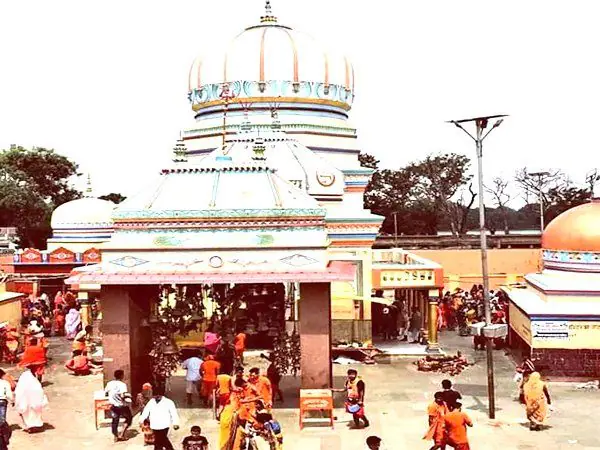
Mahendra Nath Temple, also known as Mehdar Dham, is one of the most revered and ancient Hindu temples in Bihar, India. Located in Mehdar village of Siwan district, about 32–35km south of Siwan’s district headquarters, this shrine is not merely a site of religious worship but a place entwined with healing legends, miraculous stories, and centuries-old history.
Historical Roots: Legend and Foundation
The temple holds a unique place in the cultural and religious tapestry of the region. Its origins are attributed to the Nepalese king Mahendraveer Vikram Sahadev in the 17th century (some sources suggest even older ties, potentially as far back as the era of the Sena or Pala dynasties). The king, afflicted with a chronic skin disease (leprosy), was traveling to Varanasi in search of a cure but ended up resting under a peepal tree by a pond in Mehdar village.
Desperate for relief, King Mahendra washed his hands in a small watery pit, and miraculously, his ailment began to heal. That very night, Lord Shiva appeared in his dream, advising him to excavate beneath the peepal tree. The king did so the next day and uncovered a hidden Shivling (symbolic representation of Lord Shiva). At the deity’s divine suggestion, the king constructed a temple at the site and excavated a large pond nearby, now known as Kamaldah Sarovar, spreading over 52 bighas. The temple was named Mahendra Nath Temple in reverence to its royal patron and as a tribute to the merciful deity Shiva.
Architectural Beauty and Layout
The temple epitomizes the grandeur of traditional North Indian temple architecture. The complex boasts:
- Shikhara (Tower): Its towering spire is visible from afar, embodying classic Nagara style.
- Mandapa (Hall): A pillared hall where devotees gather for worship and rituals.
- Garbhagriha (Sanctum): The innermost chamber houses the ancient Shivling, the focal point for prayer.
- Ornate Carvings: Both interior and exterior walls are adorned with intricate reliefs and sculptures depicting deities, mythological tales, and motifs from Ramayana/Mahabharata.
- Bells: Hundreds of bells, small and large, hang from the mandap to the shikhara, resonating with the chants of “Har Har Mahadev.”
- Holy Pond: The Kamaldah Sarovar is not just a scenic spot but an integral part of the temple complex. Pilgrims bathe before entering the temple, and the pond is especially picturesque in November when lotus flowers bloom and migratory birds arrive.
Within the temple grounds are shrines dedicated to Goddess Parvati, Lord Ganesha, Lord Hanuman, and images of Lord Ram and Sita—underscoring the temple’s spiritual inclusivity and cultural depth.
Spiritual Significance and Beliefs
Mahendra Nath Temple is renowned for fulfilling prayers, particularly those related to fertility and health. A robust local belief holds that any devotee who performs “jalabhishek” (ceremonial pouring of water) on the Shivling is blessed with children and receives relief from dermatological ailments, echoing the miraculous healing of King Mahendra himself.
For devotees and pilgrims, a visit symbolizes hope and spiritual renewal, making it an essential stop during the holy month of Shravan and during Maha Shivaratri, when thousands of devotees flock to the temple. Unique to the temple is the ritual during Shivaratri, in which the symbolic wedding of Lord Shiva and Parvati is enacted, and the “Shiv Baraat” becomes the main highlight of the extravaganza.
Festivals and Events
Some of the prominent festivals observed here include:
- Maha Shivaratri: Marked by all-night vigil, bhajans, and a grand “Shiv-Parvati Vivah.” Hundreds of thousands offer water and milk to the Shivling.
- Shravan Maas: A month dedicated to Lord Shiva, sees an influx of pilgrims, especially on Mondays.
- Dussehra: The temple is abuzz with continuous recitations of hymns and scriptures, and the surroundings come alive with processions and fairs.
Accessibility and Visitor Information
- By Road/Rail: The temple is 32km from Siwan and can be accessed via local buses or taxis. Mahendra Nath Halt railway station is the closest point for train travelers.
- Nearest Airport: Patna, with a range of transit options onward to Siwan.
- Local Facilities: The area supports guest accommodations and basic amenities for visitors, especially during festivals.
Other Attractions
- Kamaldah Sarovar: The sacred pond adjacent to the temple.
- Nearby Shrines: Parvati temple, Hanuman temple, and shrines for Ram and Sita, Kal Bhairav, etc.
Annual Mahotsavs (Fairs): These enrich the temple’s social and cultural vibrancy, blending devotion with communal celebration.
Legacy and Importance
Mahendra Nath Temple is more than a place of worship; it is a living chronicle of faith, hope, and tradition. The narrative of King Mahendra’s miracle, combined with the temple’s architectural magnificence and the enduring devotion of the people, makes it an eternal symbol of Shiva’s grace and the spiritual wealth of Bihar.
Conclusion
Rich in legend, beauty, and fervor, Mahendra Nath Temple stands as a shining beacon of Bihar’s sacred geography. From the mystical healing of a Nepalese king to the throngs of modern-day devotees, its legacy continues to transcend generations. The serene ambiance, the echoing bells, the lotus-filled pond, and the steadfast Shivling—together, they offer not just a pilgrimage, but an immersion into history, hope, and the undying power of devotion.
